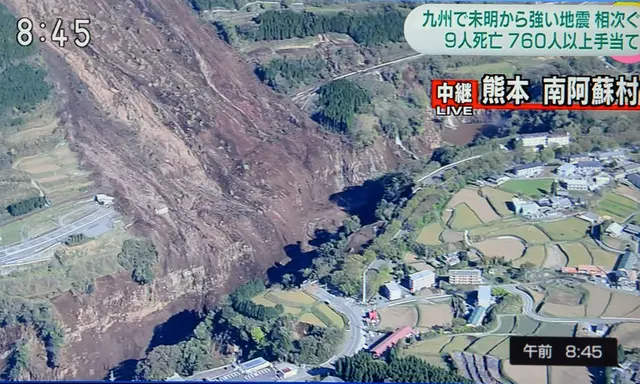At least six people were killed and 500 others hospitalized after a powerful 7.3-magnitude earthquake rocked Kumamoto Prefecture in Japan's southwest early Saturday.
Prefecture officials said as of Saturday morning more than 500 people had been treated in hospitals as a result of the latest quake, with the number of injured expected to increase as search and rescue operations continue throughout the day.
Japan's top government spokesperson Chief Cabinet Secretary Yoshihide Suga said that government would dispatch 20,000 more Self-Defense Forces to assist teams already on the ground.
The relief efforts might be hampered in the quake-hit region where 200,000 houses were left without power.
The initial quake on Saturday struck at 01:25 local time and was upgraded from a provisional magnitude of 7.1 to 7.3, with the temblor being felt across wide swathes of southern Japan and triggering a tsunami warning.
As the situation in Kumamoto continued to escalate, a second quake registering magnitude-5.8 also struck in the region two hours later with a seismic intensity of upper 6 on the Japanese scale that peaks at 7 at its center.
Japanese Prime Minister Shinzo Abe's planned trip to the quake- ravaged region, scheduled for Saturday, was cancelled following the latest quakes and the likelihood of further aftershocks.
The Japanese leader told reporters that the damage caused by the quakes could, in fact, be far more severe than already reported.
The Japanese government top spokesman Yoshihide Suga previously told a press briefing that significant damaged was feared to have been caused in the quake-battered region, with prefectural officials saying that a city hall building had partially collapsed in the city of Uto in the embattled prefecture.
Local media reported that along with the six deaths as a result of the latest quakes, some people remained trapped beneath collapsed buildings and rubble as search and rescue operations swung into high gear in the light of day.
A blaze was seen to have erupted in a residential apartment building in Yatsushiro City in Kumamoto and there have also been reports of people trapped inside a nursing home in Mashiki in southern Kyushu. Japan's Fire and Disaster Management Agency said 66 people were trapped inside the nursing home in what was the the hardest-hit town by the quakes on Friday.
Suga has also said he had received reports that as many as 80 people were believed to be still trapped or buried in debris and emergency teams and medical staff were desperately trying to extricate them and provide medical attention on the spot.
One of the many aftershocks centered in neighboring Oita Prefecture resulted in numerous injuries being reported, local media said, as houses were seen to have collapsed in the town of Yufu, which is known for its natural hot springs and resort facilities.
Local officials in Kumamoto Prefecture said that water is rising to dangerous levels at a farming reservoir in Nishihara Village as a result of the quake.
Authorities there have been forced to issue an evacuation order for possible flooding along the banks of the river, as the wider region is expected to be hit with torrential rainfall throughout the weekend.
Japan's Meteorological Agency (JMA) rattled the nation's nerves by initially issuing a tsunami warning just two minutes after the main quake struck in the early hours of Saturday, saying that waves of up to one meter could hit the coast of Japan, with the advisory given for both the Ariake and Yatsushiro sea areas.
The sea area is surrounded by Fukuoka, Saga, Nagasaki, and Kumamoto Prefectures and the latter is a shallow semi-enclosed inland sea separating the island of Kyushu from the Amakusa Islands.
The JMA later lifted the warning, but said more aftershocks are expected as well as possible landslides and buildings collapsing as heavy downpours are expected through the day and possibly into the night.
In the town of Mashiki, home to more than 32,600 people in Kumamoto Prefecture, the epicenter of the previous major quake on Friday, which was logged at an intensity of 7, the National Police Agency said local emergency services had been deluged with calls through the night and into Saturday morning following further reports of collapsed buildings in the region.
They said rescue services were bracing for more casualties.
According to Xinhua reporters in Mashiki, aftershocks could still be felt hitting regularly and there was widespread panic in the town with people seen fleeing from buildings to open areas.
Prefectural officials confirmed once again on Saturday that no abnormalities had been noticed at any of the nuclear facilities in the quake-affected areas.
Kyushu Electric Power Company said following Friday's quake that its No.1 and No.2 reactors at its Sendai nuclear power plant in Satsuma-Sendai City, in the quake-hit prefecture, were functioning normally. The two are the only reactors currently online in Japan.
The majority of Japan's nuclear power plants remain offline for regular safety inspections. The massive earthquake-triggered tsunami in March 2011, which pummeled the Daiichi nuclear facility in northeatern Fukushima Prefecture, led to the worst commercial nuclear crisis in history.
Following Saturday's quake, large sections along major arterial routes and expressways have been closed off, the traffic information center said.
 简体中文
简体中文

